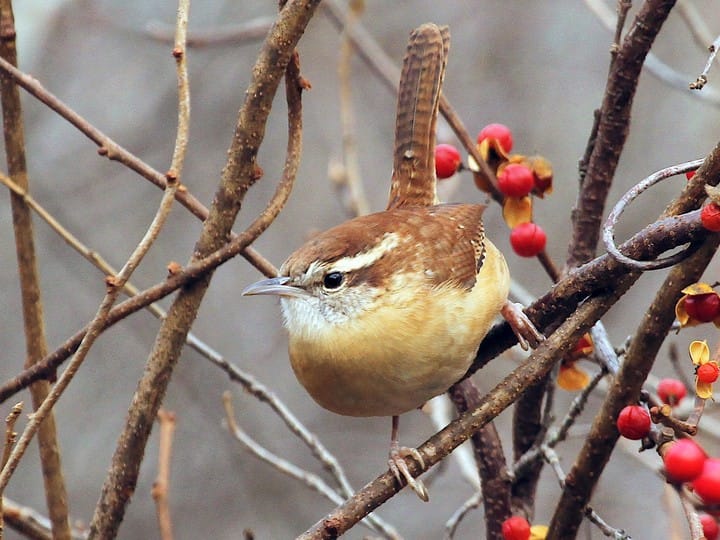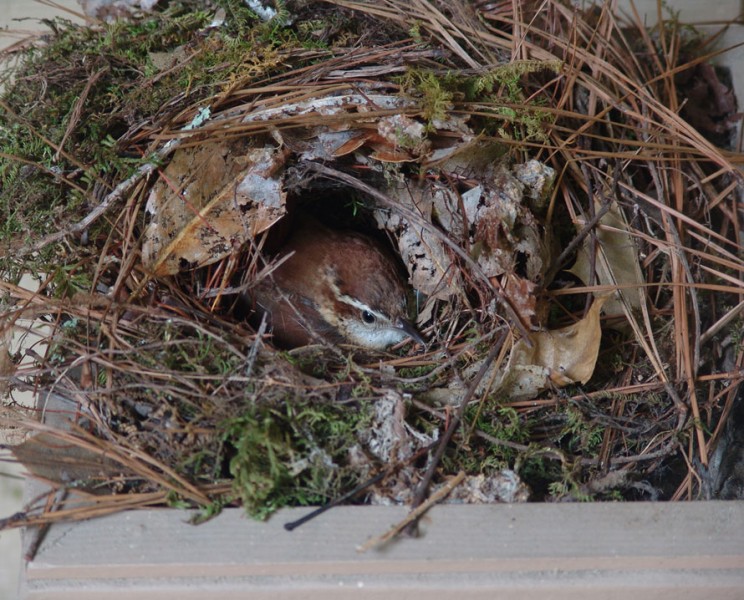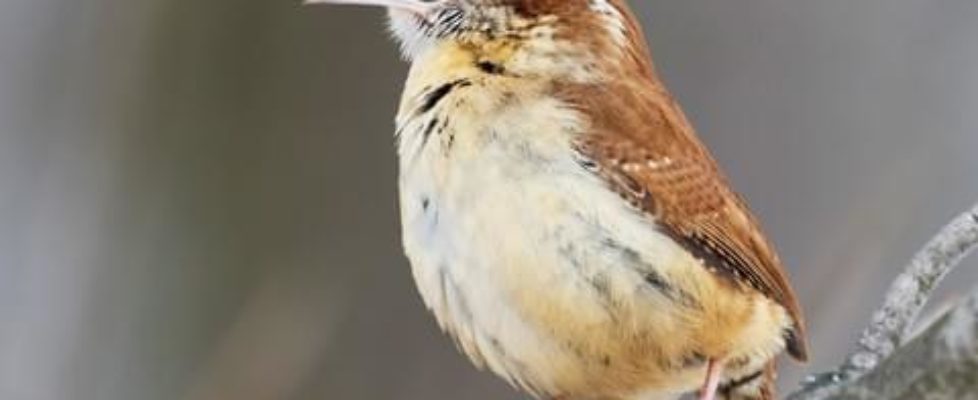Those Noisy Neighbors
It had already been a long night. I’d worked late, and after finally making it to bed had tossed and turned before finally slipping into an uneasy sleep.
I’d given myself permission to sleep late the next morning, but it turned out the choice wasn’t mine to make. At first light, a joyous song—“Teakettle Teakettle, Teakettle, Tea!”—rang in the new December day from just outside the bedroom window. A moment later, it was joined by a second. And then a third.
I lay there for several minutes, listening to the three vocalists vying to show who could greet the day most enthusiastically, before bowing to the inevitable and hauling myself out of bed. I knew who these songsters were (as, I’m sure, do many of you): Carolina Wrens, the definition of persistently noisy neighbors. There would be no more sleep for me that morning.
Today, the boldly patterned, endlessly active, and bright-eyed Carolina Wren is one of the Northeast’s most familiar year-round species. But it wasn’t always this way. The first time I saw one, I was a teenager on Cape Cod, birding with my dad. When we spotted a buffy little bird perching on a nearby branch and letting loose with a ringing song, we had to pull out our trusty Peterson’s field guide to tell us what it was.
This was in the 1970s. The Carolina Wren was already breeding in parts of the Northeast back then, but its true home was largely the Southern states. (It’s the state bird of South Carolina.) In the decades since, though, the wren has steadily expanded its breeding range northward, today nesting as far north as Ontario and Quebec. It has also begun to overwinter in some of its northern range; hence the clamor that awoke me to a December dawn.
As with other “southern” species (e.g., Black Vulture) that now spend the winters here, the wren’s expansion is partly due to our warming climate. Other human-wrought changes to the environment, however, have also helped.

in the lower Hudson Valley now
but this was not always true.
[www.allaboutbirds.org/guide/Carolina_Wren/id]
For example, the birds’ preferred habitat includes vine tangles, woodpiles, and secondary forest with dense underbrush below, all of which are in abundant supply in northern suburbs and parks. And, like many other birds that eat mostly insects and spiders during warm weather, the wrens switch to a mainly seed-based diet in the winters, and therefore can rely on backyard birdfeeders. (Where, I can report from personal observation, they shovel large quantities of seed to the ground while seemingly searching for the most delicious ones.)
Yet the story of the Carolina Wren’s recent success in our area goes deeper than the warming climate, habitat, and food supplies. Many of its most distinctive (and entertaining) advantages are specific to the wren alone.
For instance, most birds sing almost exclusively during nesting season, but—as we well know—not Carolina Wrens. Vocal all year round, and territorial, too, they are on the lookout for a mate at any time of year. And once they’ve paired up, they usually stay together for life.
This means no muss, no fuss, no wasting precious warm-weather days seeking a partner. Come the first hint of spring and they’re ready to get to work on the nest.
Nor are they picky about where they choose to raise their young. Although all Carolina Wrens nest in cavities, their definition of that word is exceedingly generous. Along with the traditional holes in trees, they’ve been known to choose boots, mailboxes, working light fixtures, the pockets of jackets hanging on nails, and a host of other “cavities”…and to raise their young successfully in every one.
The rewards of an early start and flexibility in nesting sites are dramatic. While most species raise only a single brood each year, Carolina Wrens can successfully rear as many as three—with as many as seven eggs each time—in a single breeding season.

often tucked into in unusual locations, on or near buildings,
or in cavities of trees.
Photo: allaboutbirds.org
In the north, severe and snowy winters will often cause wren populations to crash. But the birds’ ability to produce so many young means that these populations usually bounce back quickly. In fact, the number of Carolina Wrens in the Northeast has been increasing steadily during the past few decades. (Recent Christmas Bird Counts throughout our region turned up record totals of the species.)
While I confess that didn’t feel much affection for them as I lay awake that cold winter morning, Carolina Wrens have become among my favorite birds. By singing anytime, eating anything, and nesting anywhere, they seem like true survivors, ever ready to take on whatever challenges the dangerous world throws at them. That’s a bird I’m happy to sing the praises of—day, night, or crack of dawn.
By Joseph Wallace
Copyright © 2021



